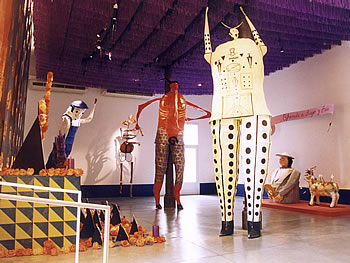El Mundo de Diego Rivera
El artista mexicano Humberto Spíndola ha trabajado durante mas de 20 años en la recuperación de técnicas ancestrales del arte en papel mexicano para reintroducirlas al lenguaje del arte contemporáneo.
En la sala "El mundo de Diego Rivera" se presenta una Ofrenda Muertos en homenaje a Diego y Frida. Este festejo se realiza tradicionalmente en México el 2 de noviembre. Durante esta fiesta popular, se realizan altares de ofrendas con comida para los difuntos, que son un banquete para toda la familia. Las comidas y elementos elegidos para los altares y ofrendas son los preferidos por los difuntos en vida.
Diego Rivera fue un apasionado coleccionista y reivindicador del arte popular mexicano y su colección incluye una gran cantidad de judas de papel que lo acompañaron durante toda su vida.
Es por esta razón que Humberto Spíndola reconstruye estos judas, y los incluye en su altar. Los judas, algunos de más de 4 metros de alto, eran originalmente quemados durante el sábado santo, y en la explosión liberaban regalos que la gente recogía. Dado el peligro que esta fiesta representaba, y a causa de los cambios en la liturgia católica, esta fiesta dejó de realizarse en la década del '40, razón por la cual la tradicional construcción de los judas quedó en el olvido. Para su realización se recuperaron las técnicas artesanales de construcción en carrizo (una especie de bambú) y las técnicas de pintura con cal y anilinas.
Otro de los grandes iconos mexicanos relacionados con la muerte en México es la Catrina. Este personaje, creado en los grabados de José Guadalupe Posadas, fue tomado por Diego Rivera como figura central del mural "Sueño de una tarde dominical en la Alameda Central". Catrina significa "elegante, refinado con cierta pretensión", es por eso que la Catrina es una imagen de la muerte elegantemente vestida con un gran sombrero y una boa de plumas. En el mural, la Catrina toma del brazo a José Guadalupe Posadas, lleva de la mano a Diego Rivera niño y está escoltado por Frida Kahlo. Los acompañan numerosos personajes de la historia de México.
Se presenta una reproducción de la sección central del mural, que será el punto de partida de una preformance en la que la Catrina "saldrá" del mural, vestida con su elegante traje de papel para conversar con el público sobre el tiempo pasado y los cambios del presente.
The Mexican artist Humberto Spindola has worked during almost 20 years in the recovery of the ancestral techniques of the Mexican paper art, reintroducing them into the language of the contemporary art.
The room "the world of Diego Rivera" presents an Offering in tribute to Diego and Frida. The Altar or Offering of Died is traditionally made in Mexico on November 2nd. During this popular celebration, altars of offerings with food for the deceaseds are made; they are a banquet for all the family. The meals and elements chosen for the altars and offerings are those that the deceaseds liked.
Diego Rivera was an enthusiastic collector and he vindicated the Mexican popular art. His collection includes a great number of judas of paper that accompanied him during all his life.
Humberto Spindola reconstructs these judas, and includes them in his altar. Originally, the judas (some of them has more than 4 meters height) were burned during the Holy Saturday, and in the explosion they released gifts that people gathered. Considering the danger that this celebration represented, and because of the changes in the catholic liturgy, this celebration was abandoned in the 40s, and the traditional construction of the judas was forgotten. For their accomplishment the artisan recovered techniques of construction in carrizo (a type of bamboo) and the painting techniques with lime and anilines.
Another one of the great Mexican icons related to the death in Mexico is the Catrina. This personage, created in the engravings of Jose Guadalupe Posadas, was taken by Diego Rivera as the central figure of his mural "Sueño de una Tarde Dominical en Alameda Central". Catrina means "elegant, refined and with certain pretension", that's why the Catrina is an image of the death elegantly dressed with a great hat and a boa of feathers. In the mural, the Catrina takes the arm of Jose Guadalupe Posadas, she carries a young Diego Rivera by his hand and she is escorted by Frida Kahlo. They accompany numerous personages of the Mexican history.
A reproduction of the central section of the mural appears in this room. That will be the departure point of a preformance in which the Catrina "will leave" the mural, dressed in her elegant suit of paper to talk with the public.
